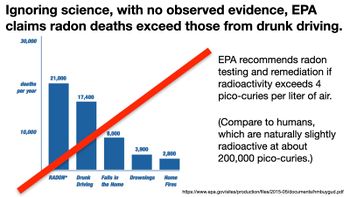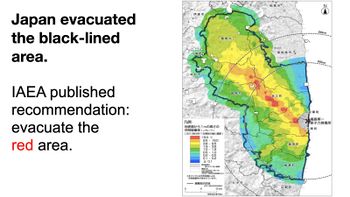Fear of radiation: Difference between revisions
Pat Palmer (talk | contribs) (replacing the "See also" with a link to the Nuclear power reconsidered article in the first sentence) |
(→Further Reading: clarify explanation of DNA repair) |
||
| Line 15: | Line 15: | ||
=Further Reading= | =Further Reading= | ||
For a more complete discussion of radiation fear | For a more complete discussion of radiation fear, its effect on public policy, and how radiation damage to our DNA is actually repaired, see Section 6 of ''ElectrifyingOurWorld.com'' by [[Robert Hargraves/Definition|Robert Hargraves]], a founder of [[ThorCon nuclear reactor|ThorCon]].<ref>[https://electrifyingourworld.com ElectrifyingOurWorld.com] by Robert Hargraves; see [https://electrifyingourworld.com/?page_id=834 Section 6] on radiation fear and its impact on public policy and nuclear power; last access 12/27/2022.</ref> | ||
For the pro-LNT point of view, see ''Hold Fast to Linear No-Threshold for Radiation Protection'', Bemnet Alemayehu, Natural Resources Defense Council, 2016.<ref>[https://www.nrdc.org/experts/bemnet-alemayehu/hold-fast-linear-no-threshold-radiation-protection Hold Fast to Linear No-Threshold for Radiation Protection], Bemnet Alemayehu, Natural Resources Defense Council, 2016; last access 12/27/2022.</ref> | For the pro-LNT point of view, see ''Hold Fast to Linear No-Threshold for Radiation Protection'', Bemnet Alemayehu, Natural Resources Defense Council, 2016.<ref>[https://www.nrdc.org/experts/bemnet-alemayehu/hold-fast-linear-no-threshold-radiation-protection Hold Fast to Linear No-Threshold for Radiation Protection], Bemnet Alemayehu, Natural Resources Defense Council, 2016; last access 12/27/2022.</ref> | ||
Revision as of 11:55, 3 January 2023
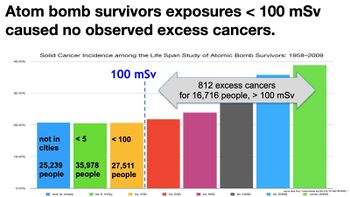
Fig.1 Exposures up to 100mSv in a short time won't overwhelm our immune systems.[1]
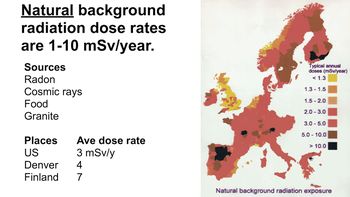
Fear of radiation is one of the barriers to reconsidering nuclear power. Government agencies have for decades assumed that deaths and other bad effects of radiation on our health follow a model called Linear No Threshold (LNT), in which death and disease is directly proportional to the total cumulative radiation, no matter how low the rate, even as low as the normal background radiation from space and the materials around us. This assumption ignores the data on low exposures (Figs.1&2) and the role of DNA repair in mitigating the damage done by low doses of radiation (Fig.3). Without a repair mechanism, the number of DNA breaks would simply accumulate in a linear fashion, no matter how low the exposure.

Fig.3 Natural breakage and repair of our DNA occurs much faster than damage from low levels of radiation.[3]
Over reliance on the LNT model has led to policies that are very costly, like radon remediation in old homes (Fig.4) and over-reaction to radiation accidents, like the evacuation after Fukushima (Fig.5), which caused far more deaths that the accident itself (Fig.6). It has also led to excessive fear of radiation from medical x-rays and other nuclear medicine procedures which save thousands of lives.
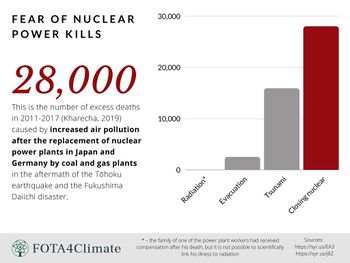
The LNT model has also been used to argue against expansion of nuclear power. It has lead to the belief that an accident causing a small increase in radiation over a very large area could lead to a large number of cancers and deaths. A more realistic assessment will show that the danger from nuclear power is much smaller than the public believes, and much smaller that the risks from ever-increasing CO2 in our atmosphere.
Further Reading
For a more complete discussion of radiation fear, its effect on public policy, and how radiation damage to our DNA is actually repaired, see Section 6 of ElectrifyingOurWorld.com by Robert Hargraves, a founder of ThorCon.[5]
For the pro-LNT point of view, see Hold Fast to Linear No-Threshold for Radiation Protection, Bemnet Alemayehu, Natural Resources Defense Council, 2016.[6]
For a review of the history of the LNT controversy, see The Two Lies that Killed Nuclear Power, Jack Devanney, Principle Engineer, ThorCon USA, 2022.[7]
For a review of the data underlying the LNT controversy, see Risk of low-dose radiation and the BEIR VII report: A critical review of what it does and doesn’t say.[8]
For the latest and most thorough review, see the UNSCEAR 2019 Report from the United Nations Scientific Committee on the Effects of Atomic Radiation.[9]
Notes and References
- ↑ Grant 2017 "Solid Cancer Incidence among Atomic Bomb Survivors: 1958–2009" E.J.Grant, et.al., Radiation Research, 187(5):513-537 (2017), see Table 3 for data.
- ↑ Map of natural background radiation
- ↑ https://en.wikipedia.org/wiki/DNA_repair
- ↑ Karecha 2019 "Implications of energy and CO2 emission changes in Japan and Germany after the Fukushima accident", Pushker Kharecha, Makiko Sato, Science Direct, Volume 132, September 2019, Pages 647-653, https://doi.org/10.1016/j.enpol.2019.05.057
- ↑ ElectrifyingOurWorld.com by Robert Hargraves; see Section 6 on radiation fear and its impact on public policy and nuclear power; last access 12/27/2022.
- ↑ Hold Fast to Linear No-Threshold for Radiation Protection, Bemnet Alemayehu, Natural Resources Defense Council, 2016; last access 12/27/2022.
- ↑ The Two Lies that Killed Nuclear Power, Jack Devanney, ThorCon USA, 2022; last access 12/27/2022.
- ↑ Risk of low-dose radiation and the BEIR VII report: A critical review of what it does and doesn’t say Michael K. O’Connor, Physica Medica 43 (2017) 153-158; last access 12/27/2022.
- ↑ UNSCEAR 2019 Report; last access 12/27/2022.
